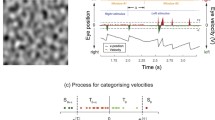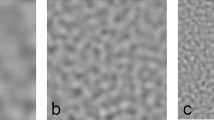Abstract
Purpose
To compare the range of ocular rotations measured by Octopus versus Goldmann perimetry.
Methods
Forty subjects (20 controls and 20 patients with impaired ocular movements) were prospectively recruited, age range 21–83 years. Range of uniocular rotations was measured in six vectors corresponding to extraocular muscle actions: 0°, 67°, 141°, 180°, 216°, 293°. Fields of binocular single vision were assessed at 30° intervals. Vector measurements were utilised to calculate an area score for the field of uniocular rotations or binocular field of single vision. Two test speeds were used for Octopus testing: 3°/ and 10°/second.
Results
Test duration was two thirds quicker for Octopus 10°/second than for 3°/second stimulus speed, and slightly quicker for Goldmann. Mean area for control subjects for uniocular field was 7910.45 degrees2 for Goldmann, 7032.14 for Octopus 3°/second and 7840.66 for Octopus 10°/second. Mean area for patient subjects of right uniocular field was 8567.21 degrees2 for Goldmann, 5906.72 for Octopus 3°/second and 8806.44 for Octopus 10°/second. Mean area for left uniocular field was 8137.49 degrees2 for Goldmann, 8127.9 for Octopus 3°/second and 8950.54 for Octopus 10°/second. Range of measured rotation was significantly larger for Octopus 10°/second speed.
Conclusions
Our results suggest that the Octopus perimeter is an acceptable alternative method of assessment for uniocular ductions and binocular field of single vision. Speed of stimulus significantly alters test duration for Octopus perimetry. Comparisons of results from both perimeters show that quantitative measurements differ, although qualitatively the results are similar. Differences per mean vectors were less than 5° (within clinically accepted variances) for both controls and patients when comparing Goldmann to Octopus 10°/second speed. However, differences were almost 10° for the patient group when comparing Goldmann to Octopus 3°/second speed. Thus, speed of stimulus must be considered if wishing to use these perimeters interchangeably.




Similar content being viewed by others
References
Hanif S, Rowe FJ, O’Connor A (2009) The comparative analysis of assessment methods for uniocular fields of fixation. Br Ir Orthopt J 6:47–51
Kestenbaum A (1961) Clinical methods of neuro ophthalmic examinations, 2nd edn. Grune and Stratton, New York
Roper-Hall G (1975) Duction measurements in limited rotations. Br Orthopt J 32:72–76
Esser J, Melzer I (1986) Comparison of monocular excursion measurements in normals and in patients with motility disorders. In: Campos E (ed). Proceedings 5th International Strabismological Association. Athena Scientific Distributors, Modena, pp 285–292
Steel DHW, Hoh HB, Potts MJ, Harrad RA (1995) Uniocular fields of fixation in Graves' orbitopathy. Eye 9:348–351
Arens B (1997) Estimation of duction ranges using visual acuity. In: Spiritus M. (ed). Transactions 23rd European Strabismological Association. Aeolus Press, Amsterdam, pp 355–360
Haggerty H, Richardson S, Mitchell KW, Dickinson AJ (2005) A modified method for measuring uniocular fields of fixation. Arch Ophthalmol 123:356–362
Gerling J, Lieb B, Kommerell G (1997-98) Duction ranges in normal probands and patients with Grave’s ophthalmopathy determined using the Goldmann perimeter. Int Ophthalmol 21:213–221
Kushner BJ (2000) The usefulness of the cervical range of motion device in the ocular motility examination. Arch Ophthalmol 18:946–950
Hanif S (2008) UK Orthoptic survey of ocular rotation measures. (personal communication)
Rowe FJ, Hanif S (2009) Uniocular ocular rotation measures: Octopus versus Goldmann. Trans. 33rd European Strabismological Association. Belgrade, Serbia. Ed: Gomez de Liano R. pp. 55–58
Haag–Streit International (2010) Octopus 900 Standard Operating procedures. http://www.haag-streit.com/produkte/perimetry/octopusr-900.html Accessed 1 June 2010
Bland JM, Altman DG (1995) Comparing methods of measurement: why plotting difference against standard method is misleading. Lancet 346:1085–1087
Rowe FJ (2006) Visual fields via the visual pathway. Blackwell Science Publications, Oxford. ISBN 1-4051-1525
Acknowledgement
We acknowledge Haag–Streit International for the research loan of an Octopus 900 perimetry used for the assessments in this study.
Declaration
This article is based on a study first reported in the Transactions of the 33rd European Strabismological Association, Belgrade, Serbia. 2009, in press. These transactions are not an open publication but only available to the members of ESA, and the scientific committee of ESA have been informed that publication in the transactions and submission to a medical journal do not constitute dual publication.
Conflict of interest
The authors do not have any commercial or proprietary interest in the Octopus 900 perimeter or Haag–Streit International. Haag–Streit has provided travel expenses for conference attendance for FJR.
Author information
Authors and Affiliations
Corresponding author
Rights and permissions
About this article
Cite this article
Rowe, F.J., Hanif, S. Uniocular and binocular fields of rotation measures: Octopus versus Goldmann. Graefes Arch Clin Exp Ophthalmol 249, 909–919 (2011). https://doi.org/10.1007/s00417-010-1596-2
Received:
Revised:
Accepted:
Published:
Issue Date:
DOI: https://doi.org/10.1007/s00417-010-1596-2




